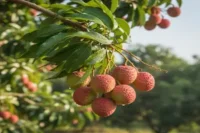10 Ginger Companion Plants to Boost Growth & Protect Ginger
Published: 11 Feb 2025
Are you struggling to keep your ginger plants healthy and pest-free? The right companion plants could be a game-changer for you. Ginger is an excellent plant but can easily fall victim to poor growth, soil depletion, and common pests like aphids. By pairing it with the right plants, you can boost its growth, naturally repel pests, and create a thriving, low-maintenance garden. I will explore the best ginger companion plants to help you solve these challenges and grow your best harvest.
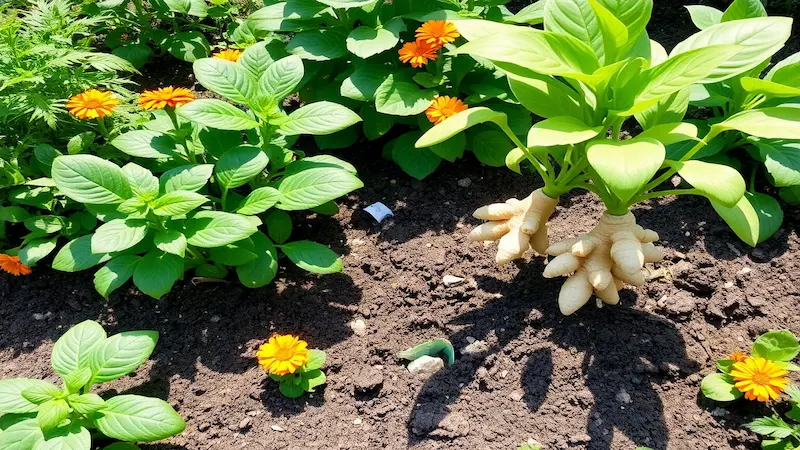
Why Ginger Companion Planting is Important
Companion planting is a smart gardening technique that helps plants thrive together. Ginger plants grow best in warm and moist environments. Companion planting improves soil health, protects against pests, and best uses your garden space, turning your ginger patch into a productive and healthy area.
Improves Soil Health
Healthy soil is the foundation of a successful garden. Some companion plants play a vital role in improving soil quality by adding essential nutrients, enhancing structure, and reducing erosion.
- Nitrogen Fixation: Beans and peas are excellent companions because they fix nitrogen in the soil. Nitrogen is crucial for ginger’s growth, as it helps produce lush green leaves and supports the development of rhizomes.
- Organic Matter Contribution: Leafy greens such as spinach can provide organic matter when their leaves fall and decompose, enriching the soil with nutrients. This makes the soil fertile and well-balanced.
- Soil Protection: Ground-cover plants like sweet potatoes act as living mulch, preventing soil erosion and keeping the soil moist—a must for ginger’s water-loving nature. These plants protect the delicate topsoil from washing away during heavy rains.
Selecting the right companion plants can boost ginger’s growth and maintain long-term soil fertility.
Natural Pest Control
Pests can quickly ruin a ginger crop. Companion planting offers a natural and eco-friendly solution. Certain plants act as natural pest repellents, keeping harmful insects at bay without the need for chemical pesticides.
- Herbs like Lemongrass and Basil: These aromatic herbs repel common pests that attack ginger, such as aphids, spider mites, and whiteflies. Their strong scent confuses pests, making it harder for them to find your ginger plants.
- Flowers like Marigolds and Nasturtiums: Not only do they brighten up your garden, but they also act as pest deterrents. Marigolds repel nematodes and other soil-borne pests, while nasturtiums attract aphids away from ginger, acting as a trap crop.
- Onions and Garlic: Known for their strong smell, these plants deter many garden pests while improving the garden’s overall health.
Using companion plants for pest control reduces your reliance on chemicals and promotes a healthier environment for ginger plants.
Maximizes Garden Space
Companion planting can help you grow more without overcrowding or sacrificing plant health if you have limited garden space. Ginger can share space with other plants that complement its growth needs.
- Layered Growth: Ginger grows low to the ground, which makes it a great companion for taller plants like peppers or okra. This creates a layered garden where each plant occupies its own vertical space.
- Efficient Use of Resources: Companion plants often have different root depths and nutrient needs, so they don’t compete for the same resources. For example, ginger pairs well with shallow-rooted herbs like cilantro, which won’t interfere with ginger’s deeper root system.
- Continuous Harvest: Planting fast-growing crops like spinach or lettuce alongside ginger means you can harvest these early crops while ginger grows. This keeps your garden productive throughout the season.
By maximizing space, you can grow a diverse range of plants, increasing the yield and beauty of your garden.
Best Companion Plants for Ginger
“Picking the right plants to grow alongside your ginger can help it thrive, keep pests at bay, and boost your garden’s overall health. Peas and clover add nutrients to the soil, while herbs like basil and cilantro are natural pest repellents.
Spinach and turmeric, which love the same warm, shady spots as ginger, are perfect buddies, too. And guess what? This isn’t just a ginger thing! If you’re curious about pairing up other plants, check out our tips for artichoke companion plants to see how to apply these tricks elsewhere in your garden. By teaming up your ginger with these plant pals, you’ll make gardening easier, get bigger harvests, and create a garden where everything works together beautifully.”
Beans and Peas
Legumes are the best companion plants for ginger because they can fix nitrogen in the soil. Nitrogen is an essential nutrient that promotes healthy foliage growth and helps ginger develop strong rhizomes.
- Nitrogen Fixation: Legumes have a special relationship with nitrogen-fixing bacteria in their roots. These bacteria take nitrogen from the air and convert it into a form that plants can use. This process enriches the soil, reducing the need for chemical fertilizers.
- Easy Maintenance: Beans and peas are low-maintenance and grow well in the same warm and sunny conditions as ginger. They don’t compete for nutrients and improve the soil for future crops.
- For example, try planting bush beans or sugar snap peas around your ginger to keep the soil fertile and healthy.
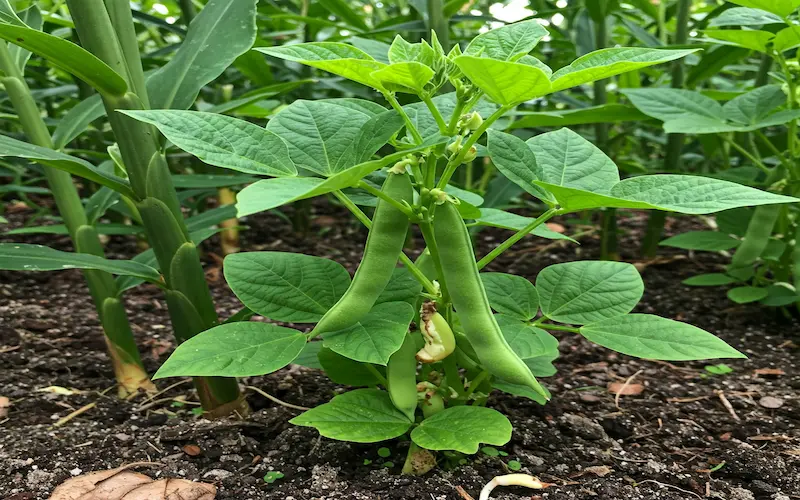
Cilantro
Cilantro repels aphids and spider mites. It also attracts beneficial insects like ladybugs and hoverflies that feed on harmful pests.
Basil
Basil has a strong fragrance and deters mosquitoes and whiteflies while adding a delicious flavour to the kitchen garden. It grows well alongside ginger, creating a fragrant and protective barrier.
Lemongrass
Lemongrass is a natural pest deterrent, especially against mosquitoes. Its tall, grassy structure also provides partial shade, which helps ginger retain moisture.
Tip: Plant lemongrass around the perimeter of your ginger patch to create a natural pest-repelling border.
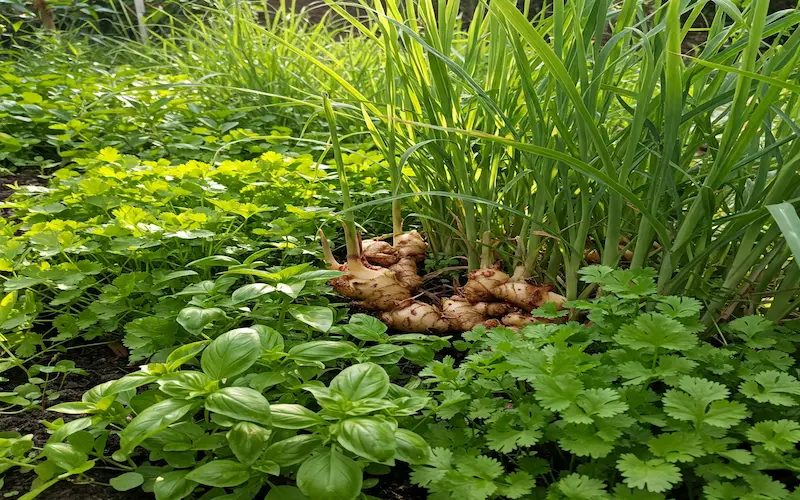
Marigolds
Marigolds are famous for repelling nematodes, tiny worms that attack ginger roots. They also help deter aphids and other soft-bodied insects. marigolds attract pollinators like bees and butterflies, which help improve the overall health of your garden.
Nasturtiums
Nasturtiums act as a trap crop, nasturtiums attract aphids away from ginger, protecting it from damage. Nasturtiums are also edible and make a lovely addition to salads. Nasturtiums also attract pollinators like bees and butterflies. It is beneficial for garden health.
Pro Tip: Plant marigolds between ginger rows for continuous protection throughout the growing season.
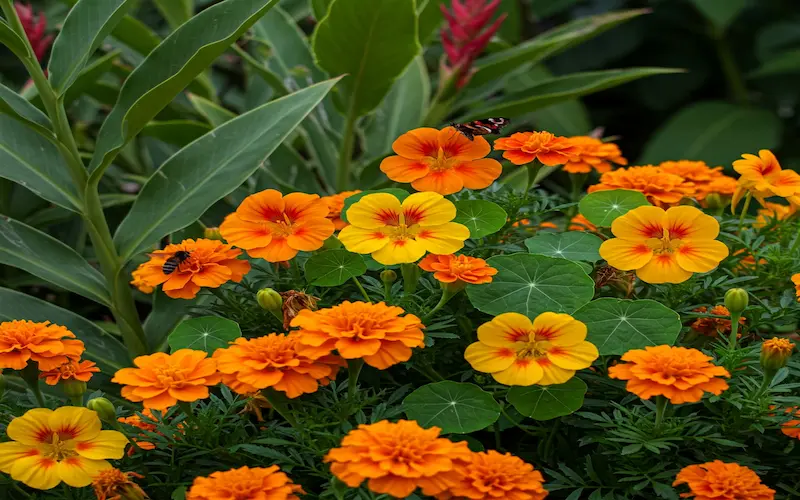
Peppers
Peppers: Bell and chilli peppers grow well without competing for nutrients. They grow in an upright direction and use space efficiently. Their strong scent helps deter pests.
Spinach
Spinach: It is a fast-growing leafy green that blooms in partial shade, making it an ideal understory plant for ginger. It provides ground cover that helps retain moisture and suppress weeds.
Sweet Potatoes
Sweet Potatoes: Like ginger, sweet potatoes love warm, well-drained soil. They spread across the ground, acting as living mulch to keep the soil cool and moist for ginger.
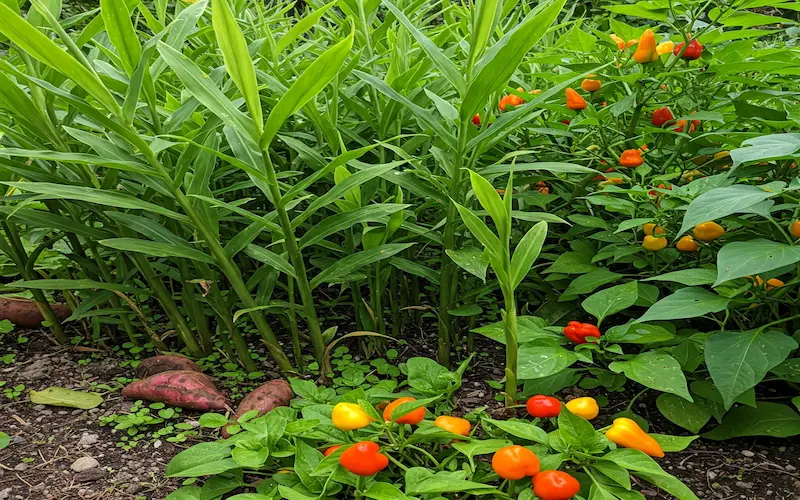
Garlic
Garlic is an excellent companion plant for ginger. It naturally repels pests like aphids and spider mites, which can harm ginger. It also helps improve soil health with its antifungal properties, reducing the chances of plant diseases. Garlic and ginger plants bloom in similar growing conditions like warm and well-drained soil, making a great pair. Adding garlic as a companion with ginger plants keeps the garden healthy, pest-free, and maximizes space.
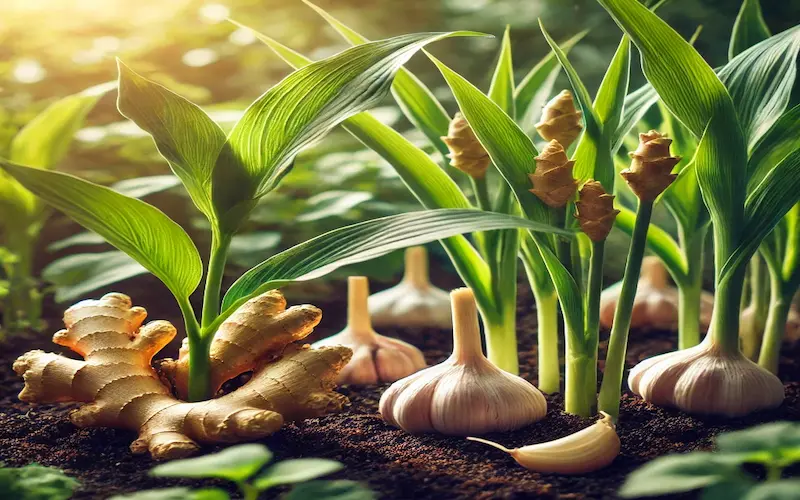
Plants to Avoid Growing Near Ginger
Companion planting is beneficial to ginger. some plants are more harmful than beneficial. Knowing which plants to avoid prevents competition for nutrients, reduces pest issues, and ensures ginger grows healthy and strong. Let’s explore the main categories of plants that shouldn’t be grown near ginger.
Ginger is a heavy feeder that requires nutrient-rich, well-drained soil. Growing it near other nutrient-demanding plants can lead to competition, leaving ginger with insufficient nutrients for healthy growth.
Corn
Corn uses a lot of nitrogen from the soil, which can quickly drain it of nutrients. Ginger also needs a lot of nitrogen to grow well. When you plant them together nitrogen remains less for the growth of ginger. It will reduce its growth and yield.
Tomatoes
Tomatoes are competed for essential nutrients like phosphorus and potassium. This competition can stunt ginger’s growth and result in poor-quality rhizomes.
Cabbage
Brassicas (Cabbage, Cauliflower, Broccoli) plants take up significant nutrients and prevent ginger from receiving what it needs. Brassicas also grow faster, potentially shading ginger and reducing its exposure to sunlight.
Carrots and Beets
Root crops like carrots and beets can attract similar soil-borne pests and fungal diseases that affect ginger roots. They can also disturb the soil structure, impacting ginger’s delicate rhizomes.
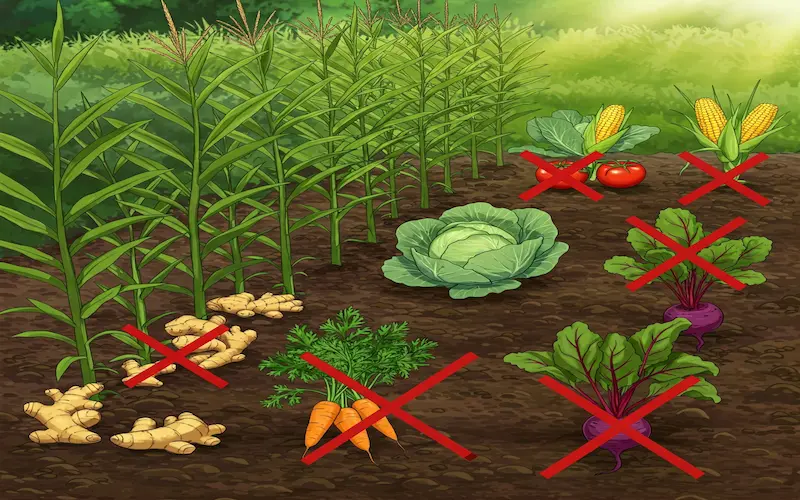
Why It Matters
Planting ginger near the wrong companions can lead to nutrient deficiencies, pest outbreaks, and crop failure. By avoiding heavy feeders and plants with shared vulnerabilities, you can ensure your ginger grows in an environment where it can thrive.
How to Plan a Ginger Companion Garden
Planning a ginger companion garden can enhance plant growth, improve soil health, and create a thriving ecosystem. Companion planting requires strategic planning to ensure plants benefit each other without competing for resources. Below are the key steps to successfully plan a ginger companion garden.
Selecting the Right Location
The success of a ginger companion garden starts with choosing the perfect location. Ginger thrives in warm, sunny environments with well-draining soil. Selecting a suitable spot ensures optimal growth for ginger and its companion plants.
- Sunlight Needs: Ginger requires partial to full sun. It is ideal to be in a location with at least 4-6 hours of sunlight daily. Similar light requirements are essential for companion plants like legumes and herbs.
- Soil Requirements: Ginger grows best in loose, well-drained soil rich in organic matter. Avoid compacted soil or areas prone to waterlogging, as standing water can lead to root rot. Consider adding compost or aged manure to improve soil fertility.
- Sheltered Spot: If your area is prone to strong winds, choose a location with some natural protection, such as near a fence or hedge. Companion plants like lemongrass can also act as windbreaks.
Spacing and Layout Tips
Proper spacing and layout are critical in a companion garden to prevent resource competition and encourage healthy plant growth. Overcrowding can lead to poor airflow, increased risk of disease, and stunted growth.
- Spacing for Ginger: Plant ginger rhizomes about 6–8 inches apart, leaving 12–16 inches between rows. This spacing ensures each plant has enough room for root development.
- Companion Plant Placement:
- Legumes (Beans, Peas): Plant legumes in alternate rows with ginger to help fix nitrogen in the soil without overcrowding.
- Herbs (Basil, Cilantro): Herbs can be planted around the edges of ginger beds, creating a natural pest-repelling border.
- Aromatic Flowers (Marigolds, Nasturtiums): Scatter these flowers throughout the garden to attract beneficial insects and deter harmful pests.
- Vegetables (Spinach, Peppers): To maximize garden space, use spinach as ground cover between ginger rows and peppers in nearby corners.
- Air Circulation: Maintain adequate spacing to improve airflow, which helps prevent fungal diseases in ginger and its companions.
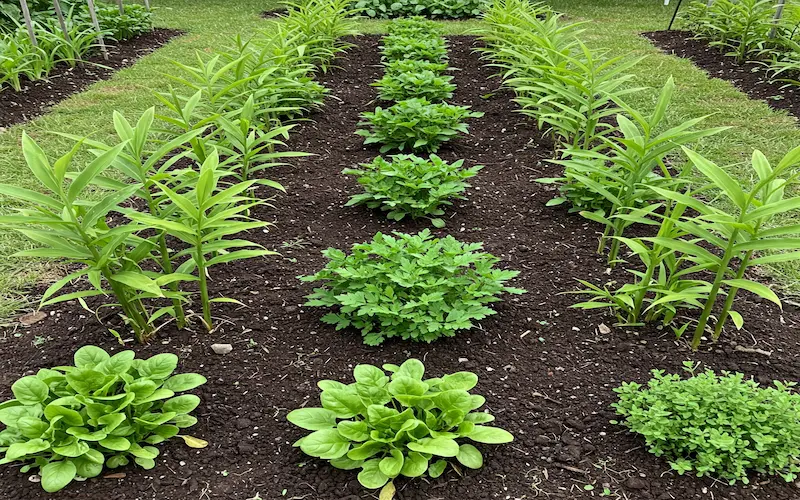
Seasonal Considerations
The timing of planting is most important for the success of a ginger companion garden. Ginger grows well in warm weather. To get maximum benefits align your companion planting strategy with the growing season.
- Planting Season: Ginger is a tropical plant that blooms well in the spring and summer. Wait until the soil temperature reaches at least 68°F (20°C) to ensure healthy growth.
- Companion Plant Timing:
- Start planting legumes and marigolds in early spring. They germinate quickly and establish a supportive environment for ginger.
- Herbs like basil and cilantro can be planted slightly later once the temperatures consistently warm up.
- Vegetables like peppers and sweet potatoes should be planted alongside ginger, as they share similar temperature and moisture needs.
- Frost Considerations: Ginger is highly sensitive to frost. Suppose you live in a cooler climate and plant ginger and its companions in containers that can be moved indoors during unexpected cold snaps.
Putting It All Together
Planning a ginger companion garden involves thoughtful preparation and attention to detail. You can create a thriving garden that supports ginger and its companions by selecting the right location, creating a well-spaced layout, and timing your planting according to the season. This approach maximizes your harvest and creates a balanced and sustainable garden ecosystem.
Let me know if you’d like to add a visual layout example or additional tips for seasonal care.
Common Questions About Ginger Companion Plants (FAQs)
When planning a ginger companion garden, many gardeners question what plants grow well with ginger and how to avoid potential pitfalls. Let’s explore some of the most common questions to help you make informed decisions.
Certain plants complement ginger beautifully by improving soil health, repelling pests, and maximizing garden space. Here’s a list of some of the best companion plants:
- Legumes (Beans and Peas): These are excellent for fixing nitrogen in the soil, which boosts ginger’s growth.
- Herbs (Basil, Cilantro, Lemongrass): Herbs like basil and cilantro repel pests like aphids, while lemongrass can deter mosquitoes and act as a windbreak.
- Aromatic Flowers (Marigolds, Nasturtiums): These flowers attract beneficial insects such as ladybugs and bees while keeping harmful pests away from ginger.
- Vegetables (Peppers, Spinach, Sweet Potatoes): These vegetables thrive in warm and moist environments similar to ginger’s. Spinach works well as a ground cover to retain moisture and suppress weeds.
It’s best to avoid planting ginger next to tomatoes or potatoes. Here’s why:
- Nutrient Competition: Tomatoes and potatoes are heavy feeders that consume large amounts of nutrients, which can leave ginger deprived of essential elements like potassium and phosphorus.
- Shared Pests and Diseases: Tomatoes and potatoes are part of the nightshade family. They prone to diseases like blight. These diseases can easily spread to nearby ginger plants.
- Root System Conflicts: Both tomatoes and potatoes have extensive root systems that can compete with ginger for space and resources.
Alternative Suggestion: If you want to grow tomatoes or potatoes, plant them in a separate garden area to avoid affecting your ginger crop.
Companion plants play a vital role in keeping ginger healthy by acting as natural pest deterrents and attracting beneficial insects. Here’s how:
- Repelling Pests: Herbs like lemongrass and basil release strong scents that confuse and repel common ginger pests such as aphids, spider mites, and whiteflies. Marigolds are particularly effective at deterring nematodes, which attack ginger roots.
- Attracting Beneficial Insects: Flowers like nasturtiums and marigolds attract ladybugs, hoverflies, and parasitic wasps that feed on harmful insects, keeping the pest population in check.
- Ground Cover Protection: Spinach and other low-growing plants protect the soil and act as a living mulch, reducing the risk of pests that thrive in exposed areas.
Conclusion
So guys, in this article, we have covered ginger companion plants in detail. Right companion plants can boost your soil with natural pest control and make your garden success. I recommend starting with legumes and aromatic herbs like basil and lemongrass. They’re easy to grow and offer great benefits. Keep experimenting and observe what works best for your garden. If you found this guide helpful, don’t forget to share it with fellow gardeners and leave a comment below about your favourite ginger companion plants!”

- Be Respectful
- Stay Relevant
- Stay Positive
- True Feedback
- Encourage Discussion
- Avoid Spamming
- No Fake News
- Don't Copy-Paste
- No Personal Attacks



- Be Respectful
- Stay Relevant
- Stay Positive
- True Feedback
- Encourage Discussion
- Avoid Spamming
- No Fake News
- Don't Copy-Paste
- No Personal Attacks

